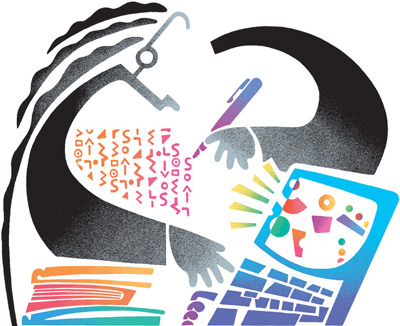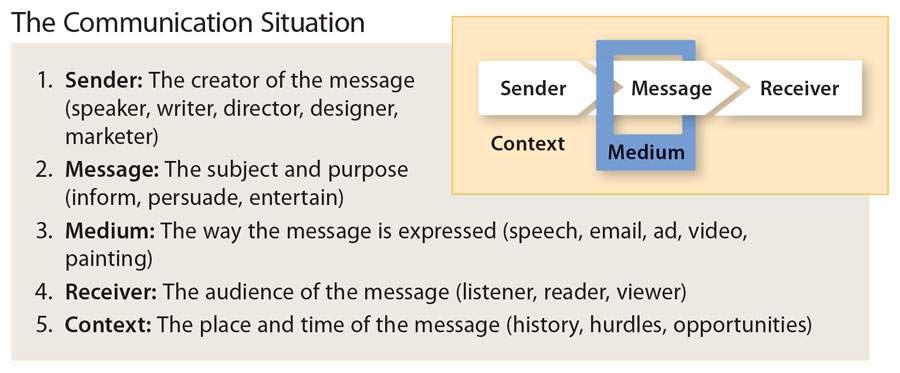
You routinely connect writing with reading, but how often do you connect writing with media literacy? It's a symbiotic relationship. You teach students to write about different topics for different audiences and purposes. They can use the same skills to engage media about different topics for different audiences and purposes.
Most writing teachers, though, wouldn’t consider themselves media-literacy coaches. They might not even know how to define media literacy: the ability to access, analyze, evaluate, and create communication in various media formats.
The same critical-thinking skills you teach in the writing process can help your students evaluate media for truth, fairness, and bias—skills increasingly necessary for academic success and responsible citizenship. Likewise, developing media-literacy skills prepares students to ethically share ideas in writing.
How can the writing process teach media literacy?
Students learn that good writing takes time—prewriting, writing, revising, and editing. As the old saying goes, "Easy writing makes hard reading, and hard writing makes easy reading." So students learn to appreciate well-crafted ideas—and, equally importantly, dismiss shoddy ideas when media are slapped together. Thoughtful writers make thoughtful readers, listeners, and viewers.
Let's look at each stage of the writing process to see how it can help you teach media literacy.
Prewriting
To meet the specific demands of a writing task, students should first consider the communication situation—sender, message, medium, receiver, and context:

Students who can analyze the rhetorical situation for writing can also analyze the same situation for the media they consume. All media is constructed, so all students can learn to deconstruct it—breaking it into its parts, considering how they work, and evaluating them. This rhetorical awareness helps students use sources ethically and reject media that uses them unethically.
This video can introduce the communication situation to your students:
And these minilessons teach students about each part of the communication situation:
- Analyzing the Sender of a Message
- Understanding a Message's Subject and Purpose
- Analyzing the Receiver of a Message
- Thinking About the Context of a Message
Writing
After prewriting, students should create a first draft, writing freely. Students who try to make everything perfect in this draft end up with "writer's block"—writing and erasing and writing and erasing until, after an hour of frustration, they have just two miserable words. Instead, students should turn off their critical minds and just pour their ideas onto the page.
Similarly, to judge media, students should first approach the content uncritically, setting aside personal biases. What is this source saying? Why? After reading or viewing, students can freewrite in response to questions like these:
- What parts of this message stick out?
- How does the information make me feel?
- How could this information be useful for me?
- How does the message compare with what I already know?
Once students have responded openly to a source, they must engage their critical thinking. They'll use the same skills they've learned for revising.
Revising
During the crucial revising step, students return to what they have written and make big improvements to their ideas, organization, voice, and style. To revise effectively, students must closely read their drafts, seeking gaps in information, weak evidence, fuzzy logic, and unclear or disorganized parts.
Students can use the same close-reading skills to critically analyze media. By picking apart the ideas, organization, and voice of media messages, students can more readily uncover false, biased, or incomplete information. And in doing so, they will avoid using or citing deceptive ideas in their own writing.
Use the following minilessons to help your students closely read media:
Editing
Editing involves fine-tuning language. In this step, students should make sure all of the words and sentences are clear and correct, checking spelling, punctuation, capitalization, and usage. You can help students build awareness of language through grammar minilessons.
Careful attention to language can help students detect unreliable information. Conspicuous errors in spelling, capitalization, or grammar are red flags about the trustworthiness of the information.
Publishing
During publishing, students consider the design and presentation of their writing and how to best deliver it to their audience.
Close attention to media introduces students to effective design strategies and opportunities for submitting their writing outside of the classroom. Consider these publishing opportunities: 38 Ways Students Can Create Digital Content
Why should I teach media literacy?
Media literacy prepares your students to engage thoughtfully with the information that surrounds them. They need to sift the signal from the noise. The skills you teach them as writers—focusing on a specific topic with a specific purpose—help them become ethical consumers of information. And all that great writing instruction you're already providing helps them become ethical producers of information, as well!